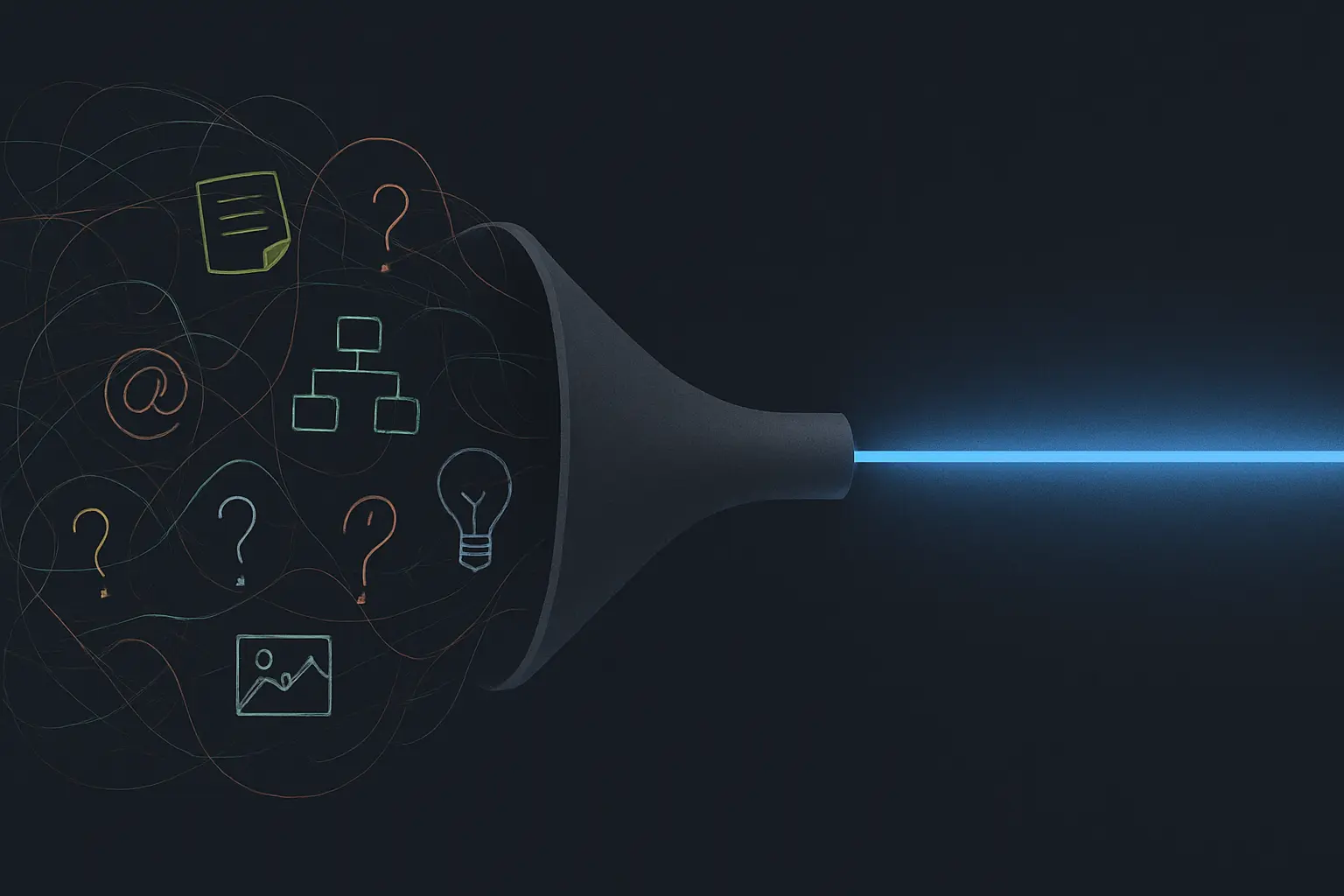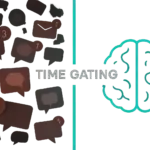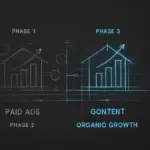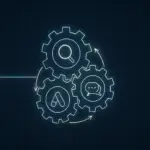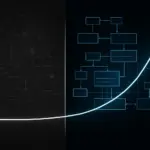The Information Flow Within My Personal Knowledge Management System
It’s a familiar feeling for any founder or operator: a great idea strikes during a call, a key insight emerges from an article, or a solution to a nagging problem appears while walking the dog. The thought is sharp, clear, and valuable. But where does it go?
For years, mine went everywhere and nowhere. A hastily typed line in a notes app, a scribbled sentence on a legal pad, a saved link in a sea of browser tabs, or worst of all, just a mental reminder to “not forget this.” This digital and mental fragmentation isn’t just messy; it’s a tax on cognitive performance. Constantly trying to hold onto these disparate pieces, my brain was running a background process that drained focus from the task at hand—a well-documented phenomenon known as the Zeigarnik effect, where our minds remain preoccupied with incomplete tasks or unhandled information. Each loose note was an open loop, silently demanding attention.
Building a system to close those loops wasn’t about „getting organized“ for its own sake. It was a strategic necessity to reclaim mental bandwidth and create a reliable engine for turning fleeting ideas into structured action. This document outlines the system I built—the path information takes from raw input to actionable knowledge within my personal Notion setup.
The Hidden Costs of Information Chaos
Before designing the system, I had to define the problems it needed to solve. The challenge isn’t just about losing good ideas; it’s about the subtle, cumulative damage that disorganized information inflicts on our ability to think clearly and execute effectively.
I found three concepts from cognitive science particularly illuminating:
1. The Forgetting Curve
In the 1880s, psychologist Hermann Ebbinghaus discovered that the human brain is a forgetting machine. His research showed that we forget roughly 50% of new information within an hour and over 70% within 24 hours. This isn’t a personal failing; it’s a feature of our biology designed for efficiency. An external system—a „second brain“—is the only reliable way to counteract this natural decay and preserve valuable insights over the long term.
2. Cognitive Load
Our working memory, the mental space where we actively process information, is incredibly limited. Cognitive Load Theory suggests that when we try to juggle too many pieces of information simultaneously—like remembering a task list, a client’s feedback, and a new idea—we overload this capacity. Performance plummets. A disorganized knowledge system forces your brain to act as a hard drive, a role it was never designed for, leaving little room for its true strength: creative and critical thinking.
3. The Cost of Context Switching
Switching between unrelated tasks or hunting for scattered information carries a heavy penalty. Research shows it can take over 23 minutes to fully regain focus after a significant interruption. When your notes on a project are in your email, the related tasks are in a separate app, and the source files are on a cloud drive, your entire workday becomes a series of exhausting context switches.
My goal was to build a system that would directly address these three challenges by creating a single, streamlined flow for all incoming knowledge.
The Four Phases of My Information Flow
My personal knowledge management (PKM) system is built around a simple, four-stage process: Capture, Process, Connect, and Create. It’s a continuous loop designed not just to store information, but to evolve it.
Phase 1: Capture — The Universal Inbox
The first rule of the system is to make capturing ideas as frictionless as possible. The harder it is to save a thought, the more likely you are to let it slip away.
To solve this, I use a single „Inbox“ database in Notion. Everything goes here first, without exception:
- Fleeting Thoughts: Quick ideas typed directly into the Notion mobile app.
- Web Clippings: Articles and resources saved via the Notion Web Clipper.
- Meeting Notes: Raw notes taken during calls.
- Emails: Important emails forwarded to my Notion inbox.
The key is to capture now and organize later. This immediately offloads the mental burden, satisfying the Zeigarnik effect and freeing my mind to stay focused on the present moment. The inbox is messy by design; its only job is to be a reliable catch-all.
Phase 2: Process — The Weekly Triage
Raw information is potential, not power. The second phase is about turning that potential into something structured. Once a week, I sit down to process my inbox to zero.
During this weekly review, I assign a destination to every item. I ask a simple set of questions for each one:
- Is this actionable? If yes, it becomes a task and is moved to my Projects database.
- Is this a resource for a current project? If yes, it’s moved into the relevant project file. This is central to my approach to building business systems, as every system needs a well-curated library of knowledge.
- Is this a piece of timeless knowledge? If yes, it gets tagged and moved to my permanent „Notes & Ideas“ library.
- Is this irrelevant? If yes, it’s deleted.
This triage is crucial. It ensures the inbox remains a temporary holding area and prevents it from becoming a digital junkyard.
Phase 3: Connect — Weaving the Web of Knowledge
This is where the system transforms from a simple filing cabinet into a true second brain. Storing notes isn’t enough; the real value comes from creating relationships between them.
In my „Notes & Ideas“ database, every note is tagged with relevant topics (e.g., „Marketing,“ „Automation,“ „System Design,“ „Leadership“). More importantly, I use Notion’s relational database features to explicitly link notes together.
For example, a note on a new customer feedback tool might be linked to:
- A permanent note on „Customer Development Frameworks.“
- A project brief for improving our user onboarding at JvG Technology.
- An idea for testing a reliable marketing automation setup to follow up on feedback.
Connecting ideas this way weaves a rich, personal web of knowledge. When I start a new project, I’m not starting from a blank page. I’m starting with a collection of interconnected thoughts and resources I’ve been cultivating for months or years.
Phase 4: Create — From Knowledge to Action
The ultimate goal of this entire system is to produce output. Knowledge that isn’t applied is just trivia. The „Create“ phase is where I use my organized and interconnected knowledge base to build tangible things.
This could be anything from drafting a strategic plan, designing a new workflow, writing a project update, or outlining a framework for building a scalable sales process. Because all the related resources and ideas are already linked within my project dashboards, I can work with clarity and speed, avoiding the constant hunt for information that plagues so many workflows.
The result is an organized workspace where the raw materials—ideas, research, notes—are readily accessible and structured around a specific outcome.
Frequently Asked Questions
When I discuss this system with other founders, a few questions always come up.
What tool do you use for this?
I use Notion. Its combination of databases, relational linking, and flexible text editing makes it uniquely suited for this kind of system. However, the tool is less important than the process. You could implement a similar flow using Obsidian, Roam Research, or even a collection of simple text files.
How long did it take to build and implement this system?
The initial build took a weekend, but the system is never „done.“ It evolves weekly. I started with just the Inbox and a simple Notes database, then added the connections, project templates, and workflows iteratively over time. The key is to start simple and let the system grow with your needs.
What’s the biggest mistake people make when starting a PKM?
There are two common pitfalls. The first is trying to build a perfect, overly complex system from day one. This leads to overwhelm and abandonment. Start with a simple inbox. The second is „collector’s fallacy“—capturing everything but processing and connecting nothing. A massive, unorganized library of notes is as useless as no library at all. The weekly processing habit is non-negotiable.
How do you decide what’s worth capturing?
My filter is simple: Does this resonate? Does it spark a connection to a problem I’m trying to solve, a project I’m working on, or an idea I’m exploring? I don’t capture everything—just what feels like a potential building block for future thinking.
From Mental Clutter to a System for Clarity
Building this information flow has been one of the highest-leverage activities for my personal productivity. It’s not just a way to remember things; it’s a system for thinking. By externalizing the burden of remembering, I’ve freed up cognitive resources for deeper, more creative work.
The anxiety of losing a good idea is gone, replaced by the quiet confidence that it has been captured and will be put to use at the right time. It’s a calm, methodical process that brings structure to the natural chaos of a founder’s mind.
If you find yourself drowning in open tabs and scattered notes, I encourage you not to look for a better note-taking app, but to first map out your own information flow. Start with a single inbox and a commitment to process it weekly. It’s the first step toward building a system that serves your thinking instead of just storing your files.
